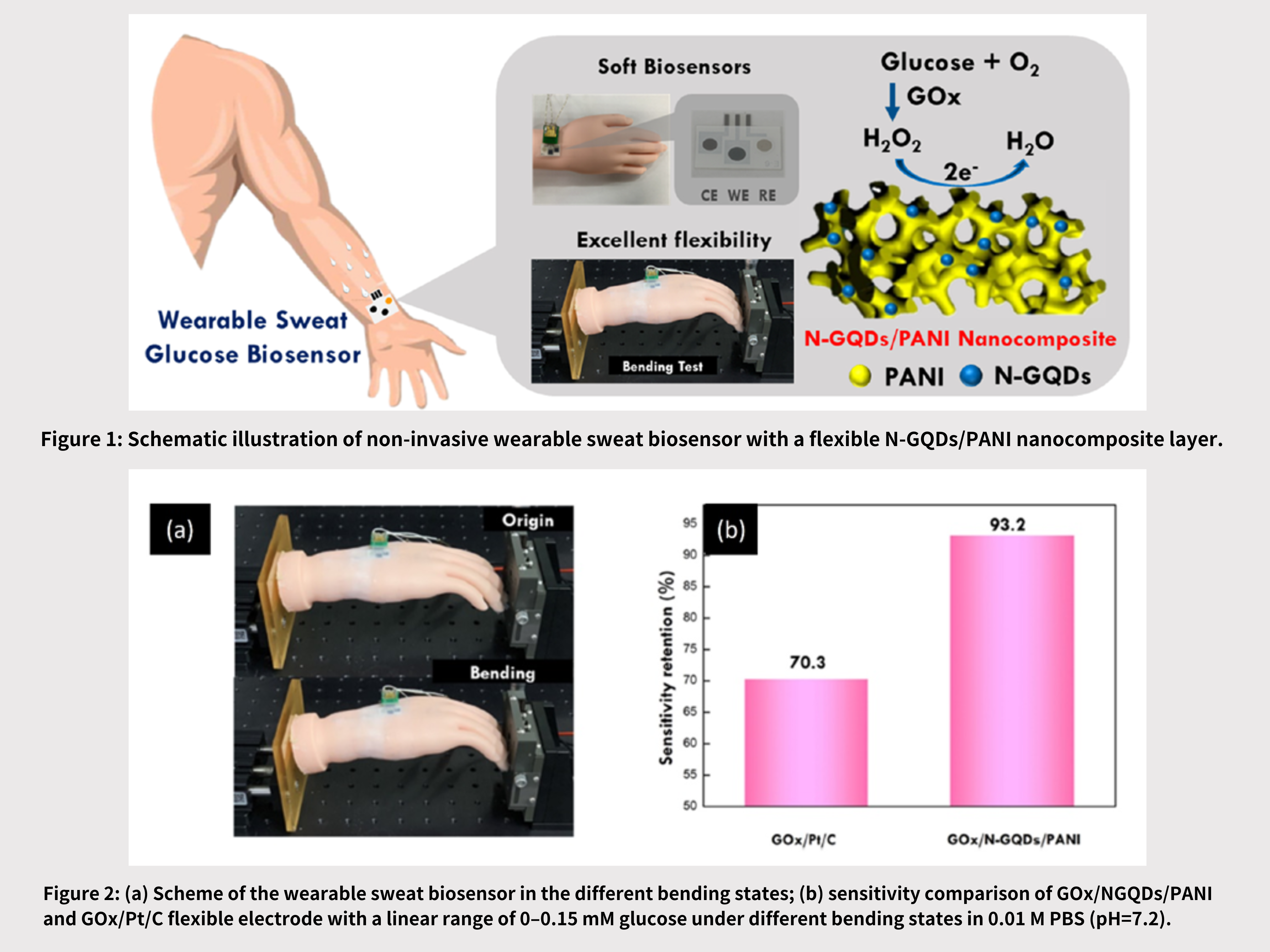Development of Nitrogen-Doped Graphene Quantum Dot with Polyaniline Nanocomposite Electrodes for Wearable Sweat Biosensors
Development of Nitrogen-Doped Graphene Quantum Dot with Polyaniline Nanocomposite Electrodes for Wearable Sweat Biosensors
By Assistant Prof. Ling-Yu Chang of Chemical Engineering and Biotechnology
As modern demands for health management rise, there is an increasing need for real-time monitoring of physiological states. Wearable biosensors that continuously monitor physiological conditions can effectively help users take preventive measures and prevent related complications. Among the various physiological parameters, monitoring blood glucose levels is crucial for the early treatment of diabetes. Recently, wearable sweat biosensors capable of non-invasive physiological signal detection have attracted attention. However, maintaining sensor sensitivity and signal stability during intense physical activity remains a significant challenge. Among the many analytes in the human body, glucose concentration is a key indicator of conditions related to hyperglycemia or hypoglycemia. Elevated glucose levels can damage various body systems, including the heart, kidneys, eyes, and nervous system, and increase the risk of cardiovascular and renal diseases. Blood glucose monitoring helps patients and doctors better manage glucose levels and adjust treatment plans in a timely manner. In recent years, there has been growing interest in wearable biosensors that analyze sweat to monitor glucose levels non-invasively. However, these sensors face several challenges, particularly in maintaining sensitivity and signal stability during intense physical activity. Intense exercise can cause cracks and damage to the sensor electrode surface, affecting its electrochemical performance. Therefore, designing sensors that offer both high sensitivity and mechanical stability is a crucial research topic.
This study designs a sensor electrode that combines high sensitivity and mechanical stability by incorporating nitrogen-doped graphene quantum dots (N-GQDs) into polyaniline (PANI) to create a composite electrode for flexible sweat biosensors. By introducing N-GQDs into PANI, the charge transfer within PANI is enhanced, thereby improving its sensitivity for glucose detection in sweat under neutral conditions. N-GQDs provide rich nitrogen-containing functional groups that facilitate electron transfer, addressing the conductivity issues of PANI in neutral electrolytes and enhancing the electrode's glucose sensing capability. The proposed N-GQDs/PANI sensor electrode has significant potential for widespread application in non-invasive wearable biosensor devices (as shown in Figure 1), enabling a long-term monitoring platform with both high sensitivity and stability. Research results show that the N-GQDs/PANI sensor electrode demonstrates superior sensitivity for hydrogen peroxide detection (68.1 ± 1.11 μA mM−1 cm−2) compared to the pure PANI sensor electrode (44.06 ± 2.10 μA mM−1 cm−2). Furthermore, after immobilizing glucose oxidase (GOx) on the electrode, the GOx/N-GQDs/PANI sensor electrode achieves a sensitivity of 28.20 μA mM−1 cm−2 for glucose concentrations ranging from 50 to 500 μM.
To investigate its flexibility, the corresponding electrode was attached to the prosthetic hand to mimic real human motion. The linear motor was utilized to bend the assembled electrodes to simulate the trivial movements of the wrist, including GOx/Pt/C based electrode (Figure 2a). Fig. 6d cleared that GOx/N-GQDs/PANI-based flexibleelectrodes retained 93.2 % (56.4 μA mM−1 cm−2) sensitivity of its initial value (60.5μA mM−1 cm−2), while the GOx/Pt/C based flexible electrodes had dramatically reduced with 29.7 % retention. To flexibility assessment of electrodes before and after the bending test showed other N-GQDs/PANI remained. Therefore, it is fair to say that the N-GQDs/PANI nanocomposite is a promising electrode material for flexible biosensors.

At the same time, the current wearable electronic devices typically rely on lithium-ion batteries as their power source. Issues related to frequent recharging due to insufficient battery life and the weight of the batteries often reduce the convenience of wearable devices. To address this problem, energy harvesting devices that can convert surrounding resources into stable electrical energy and self-powered platforms are gaining attention. Research has proposed using wearable biofuel cells powered by glucose in sweat as an energy source for wearable sensors. However, the energy produced by biofuel cells powered solely by glucose in sweat is currently insufficient to drive non-invasive sweat sensors. Overcoming this limitation could lead to a self-powered solution for long-term monitoring platforms. In the future, we hope to further apply this type of sensor electrode, which combines high sensitivity and mechanical stability, to commercial wearable biosensors. By effectively analyzing sweat composition, non-invasive sweat sensors could meet the demand for monitoring glucose or other analyte concentrations in patients.
The article was published in Sensors & Actuators: B. Chemical 383 (2023) 133617